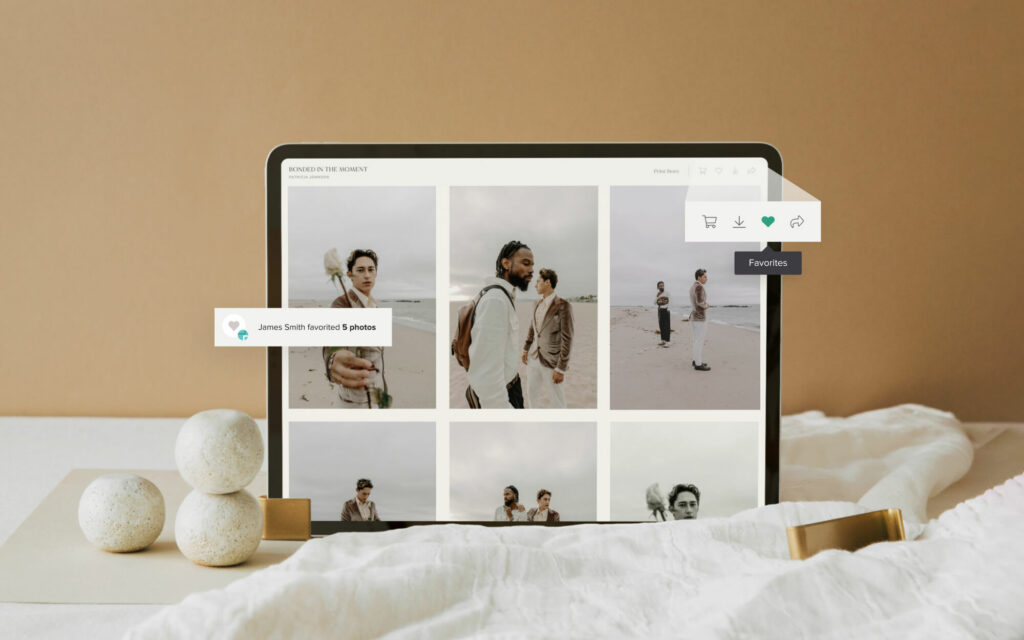BLOG

Blogging for photographers — all you need to know
One of the ways to create a sustainable business around your photography work is by investing in blogging. In today’s article, we'll explain why blogging is a great marketing strategy for any photographer and how it can help bring in new clients, improve your discoverability online and build a stronger reputation around your brand.
If you already upload photo galleries to your website and showcase your portfolio in all its beauty — know that blogging isn’t about showing your work, it’s about speaking to your potential clients. Your portfolio will always stay at the forefront of your marketing efforts because it's the DNA of everything you do. On the other hand, blogging can significantly impact how many people get to see your photos, explore your website and submit an inquiry for your services.
If you’re curious to learn how to blog in a way that facilitates your business growth, amplifies your SEO performance and contributes to higher revenues — dive right in!
1. Blogging is a marketing tool
Blogging is an instrument that helps you generate continuous interest in your creative work. The main difference between photo galleries and blogging is that the first address current clients while the second focuses on attracting new ones.

Writing with clients' interests in mind helps you dive into what's truly important for them. If you’re not sure where to start, pay attention to the questions your clients ask, or the struggles that they talk about. Address these through helpful articles, and sprinkle them with supporting photo examples from your portfolio. It’s an effective, non-salesy way to promote your work to new, potential customers.
If you are a Chicago based wedding photographer for example, you could write about:
- 11 best venues in Chicago for an outdoor summer wedding
- 5 ideas for rustic wedding in the forest
- 7 Brides who rocked their black wedding dresses in 2022
- 8 things to always have on your checklist when planning your wedding
Write about the things you have experience with, as those will help you build confidence and connect to the type of clients who share your interests and aesthetic taste.
Once you decide on the topic and contents, make sure you give your article its best chance to be found online. To maximize its success, you need to think about search engine optimization, known as SEO. When your content matches what your clients search for on Google, Safari, or Bing, you reach a broader audience, increasing your chances to get inquired. For this to happen, you need to incorporate keywords across your writing, and the more relevant they are, the better you’ll perform in search results.
When choosing keywords, think about how people search online, what words and phrases do they use. Include those exact words in your titles and paragraphs.
And, since you’re already spending time and energy to create the article, why not share that information across all your channels. Break it down into bite size posts for social media. Create a TikTok video or Instagram post addressing one of the main points from your blog post. When you present your article in various forms and formats, you can reach new segments of people.
2. Storytelling leads to a deeper connection
We are brain-wired to learn from stories due to their nature. Stories allow us to connect, feel less alone, and get the motivation to keep going. As a photographer, you are already a native storyteller at a visual level. You tell narratives through your portfolio. What you see and how you capture moments reveal details about your style, values, and interests.

Depending on your personal preferences and the story's goal, you can experiment with various ways of crafting a narrative. It can be a personal essay where you share what you love about photography. You can explore writing and interviewing with a client of yours to present how the collaboration went for both sides. Or you can present a case study of various presets.
Here are a few tips to keep in mind for any type of story that you plan to write:
- write for the reader, not for yourself
- imagine you address one person, not an entire crowd
- give context by sharing relevant details
- read your story out loud to see if it sounds coherent
Blogging is a great weapon to share your vision on a more profound level. Writing about your creative process, your journey, or useful recommendations for people who plan to hire a photographer allows you to keep momentum and make visitors return.
3. Sources of inspiration for writing stories
The Internet offers an abundance of information, but your experience is unique, and you should capitalize on that. How you approach certain things, your thoughts around topics within the industry, or how you imagine doing creative work are just some examples you can turn into blog articles. Chances are that people are looking for guidance or support and will relate precisely to what you have experienced and have to share.

The sooner you start blogging, the better it is for your online presence and business overall. You can get ideas from dozens of situations that you already go through:
- Listen carefully to your clients and take notes after your conversations. Put down everything that grabbed your attention: expressions, ideas, questions, concerns, and turn them into a blog article that sheds light on these topics.
- Write your takeaways every time you get the chance. Compile the lessons you learned after a photo session or a client meeting, and create a list for your readers.
- Pay attention to the context. Describe where you are taking photos, the people, the light, the atmosphere, etc. These details could turn into an article at some point.
- Give back to the photography community. Share your creative process, the turning points, and the experiences you have. People love to learn from other's stories.
Storytelling is not about news sharing or keeping up with the trends that come and go within the photography community. It's the opposite. Powerful narratives contain a mix of depth and vulnerability—the more personal a story is, the bigger are the chances to touch dozens of people.
4. Technical aspects of writing on the blog
When it comes to blogging, it is essential to pay attention to some important aspects. They support you in making your content searchable and getting onto the screens of the right people.

Here are a few helpful practices to consider when writing on your photography blog:
- Expand your ideas and thoughts into a minimum of 300+ words; longer texts allow search engines to understand your content better and show it to relevant people.
- Create a general structure by including an intro, body, and outro; it helps your clients easily read through the entire blog post.
- Write titles that match relevant keywords; a keyword is a search term that you want to rank for on a particular page, so when your clients search for that keyword, they should come across that page on your website.
- Use multiple headings to make your article easy to follow; if you write long-form articles that go beyond 1000 words, use a heading hierarchy (i.e. H1, H2, H3) to break down the text and make it easier for clients to read and Google to index.
- Trim your ideas in short sentences and short paragraphs for readability; shorter sentences make your text easier to read and comprehend.
- Use numbered lists and bullet points because people spend only a couple of seconds to decide whether they want to continue reading. Lists and bullet points help them skim easier through the content.
- Include alt tags and titles for images; by default, these fields are filled with the image filename, but that's a poor practice; the textual descriptions of your images impact both SEO and accessibility, making your photos discoverable, and accessible to readers with special needs.
Try to keep a healthy balance between writing to match Google's algorithm and maintaining a genuine voice. Going too much on any of these extremes will impact your blogging success.
5. Get started with blogging inside Pixieset Website
If you already use Pixieset Website, or plan to, and want to get started with blogging — you're in the right place! Blogging with Pixieset Website is a piece of cake. The blog is built-in and comes with numerous pre-made content blocks to save you time and ensure that all your posts look consistent and polished, across the board.
Depending on your style, mood, and even branding, you have dozens of possibilities to pack your stories. You can share ideas as paragraphs or columns of text. Alternatively, you can showcase images stacked on top of each other, via a beautiful grid or a slider for a more editorial look and feel. Additionally, you have ready-made layouts to add videos, quotes, headlines, quick links, and more. To help you optimize your process, you can import images into your blog directly from your Pixieset client galleries. How cool is that?
Long story short, with Pixieset Website, blogging becomes a breeze, all you have to do is lay out all your brilliant ideas and work, so that the world can see it.
Learn more about blogging with Pixieset Website here.
Making an effort to blog regularly pays off on so many levels. It reinforces your brand, puts your creative work into the spotlight, brings new business, helps you become a reference within the photography community, and so much more.
As with any endeavour that’s worth investing in, it's a long-term game in which consistency makes the difference. Start small, experiment, learn on the go, and adjust the strategy to match your business goals and philosophy. Writing stories about your craft and topics you are interested in is an excellent opportunity to make your voice heard.



 Client Gallery
Client Gallery 